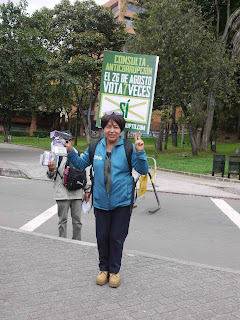 |
| Cyclists outside the Trash Museum back in the days of its full glory. |
Bogotá's least popular anti-museum is no more.
 |
| The Trash Museum asks you what you're doing to the planet. |
The Trash Museum, founded decades ago by the son of an upper-middle-class Bogotá family, became a regular stop on our bike tours, as well as a source of discord in its quiet Teusaquillo neighborhood.
As I heard the story, Antonio went to study in paris, where he rebelled against consumerism and wastefulness. He retunred hom, filled his family's house and yard with garbage. The museum became a landmark for bike tourists, but an eyesore for its neighbors, who at least once tried get to get Antonio evicted.
The house's front 'yard' was hidden behind a jumble of paper, plastic, boards and old shoes, decorated
 |
| 'We are the trash culture!' |
with signs denouncing mankind's wastefulness and announcing the planet's environmental collapse. 'How many of these objects came from your house?' asked one hand-scrawled sign. 'This is the way the world is,' announced another.
Passers-by contributed their own pieces of trash and even wrote their own statements. Sometimes, Antonio left his front door wide open, for anybody to enter and experience the museum's trash-packed interior, where he actually hosted friends.
The 'museum' even attained a degree of officialness. It was on Googe Maps and received an award from the Ministry of the Environment for environmental education.
 |
| "He was strong; a straight shooter." Antonio's brother gives us the sad news. But I suspect that the neighbors were relieved. |
 |
| A daring tourist ventures into the museum. |
And Antonio certainly had his admirers, including his brother, who described him as "strong" and "a real straight shooter."
But, as much as I agree with Antonio's ideas - Bogotá's streets, sidewalks and waterways are strewn with paper and plastic from unnecessary packaging left over from mostly unnecessary products, which will either end up rotting in the Doña Juana landfill or float into the ocean, where animals will swallow it and choke to death.
 |
A recognition from
the Ministry of
the Environment. |
But Antonio, with his ways of antagonizing people, was not the best messenger. And I´m not sure whether his 'museum' was the product of principle, or just the rationalization of laziness. After all, Antonio spent his time indoors drinking himself to death.
Neither was he a particuarly pleasant person. Once when I stopped in front of the house with a bike
tour, Antonio Emerged from a amidst his trash and greeted us with an 'Heil Hitler.'
Later, we asked him what he did for a living.
"I'm the new Adolph Hitler," he told us.
About ten days ago, Antonio died, most probably from all of his drinking. His brother is clearing out his house and yard - a monumental task - and plans to rent out the property. Check it out soon on air BnB.
 |
| Hard at work clearing out the museum. |
 |
| Ready to cart away the trash. |





















